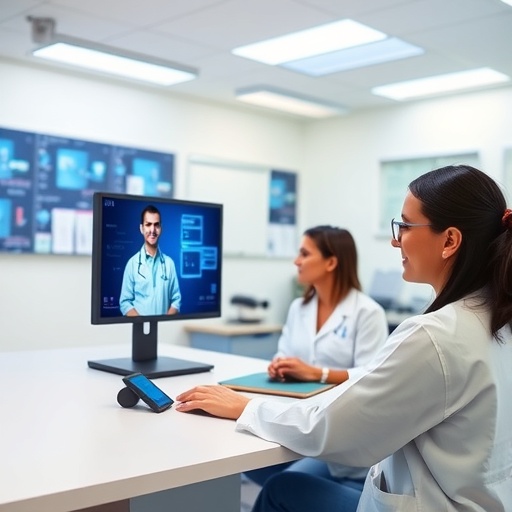In the digital age, the evolution of educational paradigms within healthcare education has reached new heights, particularly with the emergence of virtual and blended laboratories. The systematic review conducted by Safaeipour and colleagues illuminates the transformative potential of these innovative educational tools. The traditional hands-on learning experience in healthcare has encountered numerous challenges, particularly in the context of accessibility and resource availability. Virtual and blended laboratories are positioned as feasible solutions, enabling students to engage with sophisticated simulations that replicate clinical environments without the constraints of physical restrictions.
The review reveals a diverse range of methodologies employed in virtual and blended learning environments. One of the significant strengths identified is the adaptability of these platforms. They offer flexibility not only in terms of students’ schedules but also in curricular integration, allowing for a more personalized learning experience. Furthermore, these digital environments can be tailored to the specific needs of healthcare disciplines, ensuring that students gain relevant skills and knowledge pertinent to their professional requirements.
Through the systematic analysis presented in the study, a clear consensus emerges regarding the efficacy of virtual laboratories in enhancing students’ understanding of complex medical concepts. By utilizing advanced simulation technologies, students can engage in scenarios that would otherwise be difficult to recreate in traditional laboratory settings. Such immersive experiences can significantly boost retention rates and promote critical thinking, which are essential components of competent healthcare provision.
Moreover, the integration of assessment tools within virtual and blended laboratories supports real-time feedback mechanisms. This aspect is particularly crucial in healthcare education, where timely evaluations can inform learners about their performance and areas needing improvement. The immediacy of these assessments allows students to rectify misunderstandings before they solidify into practices, thereby fostering a safer healthcare environment.
The review also highlights the importance of user experience in the design of virtual laboratories. A well-structured interface can enhance engagement and drive motivation among students. Clear navigation and interactive components can make learning more enjoyable, which could ultimately lead to better educational outcomes. The authors argue that as technology continues to evolve, so too must our approach to its integration into educational frameworks.
An emerging theme in the research is the concept of collaborative learning within these virtual platforms. Students can work together in a remote setting, collaborating on projects and sharing insights, which mirrors the real-world dynamics of healthcare teams. This collaborative approach fosters essential communication skills, which are pivotal in any healthcare context. By simulating team-based problem solving in a virtual space, students can prepare for real-life scenarios where interdisciplinary cooperation is mandatory.
Despite the evident advantages, the study does not shy away from addressing the potential shortcomings of virtual laboratories. One significant challenge noted is the digital divide, which may prevent equitable access for all students. Institutions must recognize the disparity in access to technology and internet connectivity and strive to provide adequate support to ensure all learners benefit from these educational innovations. Ensuring inclusivity will be key to the widespread acceptance and success of virtual and blended laboratory approaches.
Another critical observation from the review pertains to the need for faculty training in the implementation of virtual and blended laboratories. Educators must be equipped not only with the technical skills to operate these platforms but also with the pedagogical strategies necessary to maximize their educational potential. Professional development opportunities must be offered to assist faculty members in transitioning from traditional instructional methods to innovative virtual teaching formats.
Importantly, the findings of this review can serve as a roadmap for future research in healthcare education. As the landscape of medical training continues to evolve, further investigation is needed to optimize the use of virtual laboratories. Research could explore various dimensions, such as long-term retention of knowledge, student satisfaction, and the efficacy of blended learning environments compared to traditional settings.
The authors also propose that future studies could focus on specific healthcare disciplines, investigating how virtual laboratories can address the unique challenges present in areas such as nursing, pharmacy, and allied health professions. Conducting focused research on these disciplines could lead to specialized recommendations that enhance the educational experiences tailored to the nuances of each field.
Ultimately, the systematic review by Safaeipour et al. serves as a compelling argument for the adoption of virtual and blended laboratories in healthcare education. By addressing both the opportunities and challenges presented by this innovative approach, the authors have opened the door for enhanced educational practices that can ultimately lead to better-prepared healthcare professionals. The ongoing dialogue surrounding technological integration in education represents a pivotal moment for the future of healthcare training.
As educational institutions grapple with the challenges posed by conventional methodologies, the adoption of virtual and blended laboratories stands as a promising approach to reimagine healthcare education. By embracing these innovations, future healthcare professionals can gain the practical skills and theoretical understanding necessary to thrive in increasingly complex clinical environments. Ultimately, the findings from this systematic review underscore the necessity for continuous improvement and adaptability within healthcare education frameworks, ensuring that they remain relevant and effective in preparing the next generation of healthcare leaders.
In conclusion, the work by Safaeipour et al. illuminates a pathway towards a more engaging, responsive, and effective model of healthcare education. The potential of virtual and blended laboratories signifies a shift towards a future where educational boundaries are expanded, and learning becomes a truly inclusive, personalized, and collaborative experience. As the healthcare field continues to evolve, so must our educational practices, ensuring that we cultivate a workforce equipped to meet ever-changing patient needs.
Subject of Research: The impact and effectiveness of virtual and blended laboratories in healthcare education.
Article Title: Virtual or blended laboratories for healthcare students education: a systematized review.
Article References:
Safaeipour, R., Aalaa, M., Mojtahedzadeh, R. et al. Virtual or blended laboratories for healthcare students education: a systematized review.
BMC Med Educ 25, 1352 (2025). https://doi.org/10.1186/s12909-025-07937-7
Image Credits: AI Generated
DOI: https://doi.org/10.1186/s12909-025-07937-7
Keywords: virtual laboratories, blended learning, healthcare education, systematic review, medical training, technological integration.




